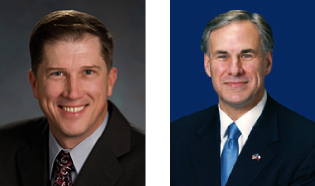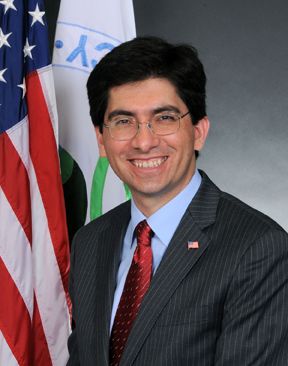By Bill Dawson

TCEQ Chairman Bryan W. Shaw & Texas Attorney General Greg Abbott: EPA threatens “to usurp state enforcement authority.”
In a combative, defiant letter, Texas officials have told the Environmental Protection Agency they will not include climate-altering greenhouse gases in the state’s emission-limiting permits for industrial plants, as federal regulations will start requiring in January.
In the letter [PDF], dated Monday, Texas Commission on Environmental Quality (TCEQ) Chairman Bryan W. Shaw and Attorney General Greg Abbott said, “Texas has neither the authority nor the intention of interpreting, ignoring, or amending its laws in order to compel the permitting of greenhouse gas emissions.”
The EPA is “threaten[ing] to usurp state enforcement authority and to federalize the permitting program of any state that fails to pledge their fealty” to the federal agency, the two officials wrote.
They added: “The United States and Texas Constitutions, United States and Texas statutes, and EPA and TCEQ rules all preclude TCEQ from declaring itself ready to require permits for greenhouse gas emissions from stationary sources as you request.”
In a statement issued Wednesday, EPA Regional Administrator Al Armendariz, who is based in Dallas, responded to the letter by saying, “EPA’s measured steps are in response to a Supreme Court decision issued more than three years ago.” He was referring to a ruling in which the court said the agency has authority under the Clean Air Act to regulate greenhouse gases and required EPA officials to show why they should not do so.
“We are not at liberty to ignore the law,” Armendariz said, “and the [Texas] letter’s unsubstantiated claims are the same sort that have been made – and ultimately proven wrong – every time EPA has, over the past forty years, moved to implement the Clean Air Act’s protections of public health and welfare.”
The state officials’ refusal to help implement the EPA’s new greenhouse-gas rules, coupled with Armenadariz’s reaction, amps up an already heated dispute between Texas and federal officials over the regulation of air pollution.
Besides opposing the EPA’s decision to start regulating greenhouse gases, Texas is simultaneously fighting the EPA over the federal agency’s disapproval of key elements of the state’s longstanding program for issuing permits for other air pollutants, such as smog-forming chemicals.
On the climate issue, Texas earlier this year formally challenged the scientific basis for the EPA’s finding that greenhouse gases pose hazards to human beings and the environment that warrant regulation.
That challenge took two forms. One was an administrative petition asking the EPA to reconsider its “endangerment finding,” which the federal agency rejected last week. The other was a legal petition, which was filed in federal court in February and is still pending.

EPA Regional Administrator Al Armendariz: “We are not at liberty to ignore the law.”
In April, the EPA and the Department of Transportation issued the first national rule to limit greenhouse emissions, which will apply to new cars and light trucks, starting on Jan. 2. In May, the EPA finalized a rule to focus its regulation of greenhouse gases from stationary sources on the largest industrial facilities, such as power plants and oil refineries. EPA officials said the vehicle rules’ introduction would trigger the start of a multi-year phase-in of the industry rules on the same day.
It was this document targeting industrial regulation on the biggest sources, called the “tailoring rule,” that drew the letter from Shaw and Abbott on Monday, which was the deadline set by the EPA for such state responses. The two state officials asked the EPA to postpone the industry rules until pending litigation over the regulations is resolved.
The EPA has called the regulations “a common sense approach” to controlling greenhouse gases, because it “tailors” them to the largest sources. To do that, the EPA decided to restrict the regulations to facilities that emit carbon dioxide and other greenhouse gases in volumes larger than minimum threshold amounts. Those minimums are much greater than the thresholds that trigger permit requirements for other regulated air pollutants.
Using the lower, statutorilydirected thresholds is not feasible because greenhouse gases “are emitted in much higher volumes,” the EPA said in a summary of the rules.
The lower thresholds “would lead to dramatic increases in the number of required permits,” and the state and local governments to which the EPA delegates permit-issuing authority “would be overwhelmed and the programs’ abilities to manage air quality would be severely impaired,” the agency said.
Texas has been among those complaining about an earlier EPA proposal that would have used lower emission thresholds and therefore would have applied to many smaller sources of greenhouse gases, too.
Gov. Rick Perry reminded his audience about the state’s objection in a speech at Houston’s Rice University last week, saying the previous version of the rules would have “included countless businesses, farms and even large churches.”
The subsequent letter by Shaw and Abbott responded to a request by the EPA in its final, published regulations that the states inform federal officials by Aug. 2 whether they would employ the same definition of “subject to regulation” that the EPA used in the rules. The federal agency adopted a definition of that legal phrase to set the emission thresholds that confine them to the largest sources.
If a state chooses not to follow this approach, the EPA asked for information about any “alternative authority” that state officials may have for including greenhouse gases in emission permits. If the state lacks such authority, the EPA asked whether the state intends “to revise its rules consistent with these applicability thresholds.”
The EPA said it will “move quickly” to make sure that permits for greenhouse-gas emissions are issued everywhere, “consistent with the final rules.”
The Greenwire news service reported Wednesday that the EPA has drafted regulations to do that: “The agency sent a proposal to the White House regulatory review office last month that seeks to guarantee authority for federal implementation plans, or FIPs, that could replace state programs if the states do not comply with federal requirements by the deadlines.”
The Shaw-Abbott letter said that the EPA’s request for information from the states had “effectively requested that Texas agree to regulate greenhouse gases in the exact manner and method proscribed by the EPA.” [The state officials certainly meant “prescribed,” since “proscribed” means “forbidden.”]
In doing so, the two officials added, “you have asked Texas to agree that when it promulgated its air quality permitting program rules for pollutants ‘subject to regulation’ in 1993, that Texas really meant to define the term ‘subject to regulation’ as set forth in the dozens of paragraphs and subparagraphs of [the EPA’s tailoring rule], first promulgated in 2010.”
Although Shaw and Abbott argued that Texas is constitutionally and statutorily “preclude[d]” from declaring itself ready to include greenhouse gases in emission permits, the section of the Texas Health and Safety Code that represents the state’s Clean Air Act includes the following language about “special problems related to air contaminant emissions.”
Consistent with applicable federal law, the commission [TCEQ] by rule may control air contaminants as necessary to protect against adverse effects related to:
(1) acid deposition;
(2) stratospheric changes, including depletion of ozone; and
(3) climatic changes, including global warming.
In contrast to the Texas code’s reference to the “adverse effects” of heat-trapping pollutants, Shaw and Abbott suggested in their letter that carbon dioxide – the main greenhouse gas produced through human activity – is not harmful:
“Notably absent from your rules,” they wrote, “is any evidence that they would achieve specific results; in fact, you assiduously (and correctly) avoid ascribing what environmental benefit may be achieved by mandating permits to emit a uniformly distributed, trace constituent of clean air, vital to all life, that is emitted by all productive activities on Earth.”
Echoing the state’s objections to the EPA’s rejection of elements of Texas’ existing air permitting program, the state officials alleged that the federal agency’s plan for regulating greenhouse gases amounts to a “plan for centralized control of industrial development.”
The EPA, they wrote, is demanding that Texas provide “a loyalty oath” and “allegiance” and “acquiescence” in “unsupported findings.”
Jim Marston, Texas regional director of the Environmental Defense Fund and a former Texas assistant attorney general, charged, however, that Texas’ stance on federal greenhouse-gas regulations is a case of “back to the future.”
The state’s refusal to implement the rules “is just like in the 50’s and 60’s when backward Southern states declared they would defy the federal government enforcing a U.S. Supreme Court decision,” he said. “Like then, the state is on the wrong side of the law and history. Abbott makes Texas look like a bunch of yahoos.”
Along with the letter from Shaw and Abbott, the state filed a brief, related legal petition last Friday in which Perry, Abbott, the TCEQ and four other state agencies asked the U.S. Court of Appeals in Washington to review the tailoring rule, which they called “contrary to the Clean Air Act.”
The Greenwire news service reported on Monday and Tuesday that several states, business organizations and environmental groups had also filed petitions regarding the tailoring rule.
On Wednesday, Greenwire reported that the Washington-based chief of a national organization representing state and local officials doubted many other states would take the same path as Texas on the issue:
Bill Becker, the executive director of the National Association of Clean Air Agencies, said Texas is in the minority when it comes to compliance with EPA’s climate rules.
“Texas is the only one I’ve heard who have said, ‘Over my dead body,’ but most others are trying to make this work,” Becker said.
“The vast majority of states will be successful in having regulations ready to go by January 2, 2011,” Becker said. “There will be some, maybe 20 percent or so, who won’t make it, but not for lack of trying. They won’t make it because either their legislature and/or regulatory bodies have processes in place that are protracted and difficult to achieve quick decisions, but they’re working toward making this program operate.”
For states that do not align with the federal program, EPA could issue FIPs to curb emissions or issue sanctions including the withholding of federal highway funding.
The battle between Texas and EPA “is going to be a shootout at the O.K. Corral,” Becker said. But he said EPA won’t give up without a fight.
“I think that EPA is very serious about taking this forward,” he said.
Some members of Congress are also serious about trying to block or at least postpone implementation of the EPA’s regulations for industrial greenhouse-gas emissions, pursuing legislative avenues for doing that.
[Editor’s note: An earlier version of this story included an incorrect date for the filing of Texas’ legal petition challenging the EPA’s finding that greenhouse gases are dangerous.]
